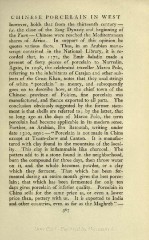Page 449 - Oriental Series Japan and China, Brinkly
P. 449
CHINESE PORCELAIN IN WEST
however, holds that from the thirteenth century
i.e. the close of the Sung Dynasty and beginning of
the Yuan Chinese ware reached the Mediterranean
shores of Africa. In support of this opinion he
quotes various facts. Thus, in an Arabian manu-
script contained in the National Library, it is re-
corded that, in 1171, the Emir Saladin made a
present of forty pieces of porcelain to Nurredin.
Again, in 1298, the celebrated traveller Marco Polo,
referring to the inhabitants of Carajan and other sub-
jects of the Great Khan, notes that they used strings
of white "porcelain" as money, and subsequently
goes on to describe how, at the chief town of the
Chinese province of Fokien, fine porcelain was
manufactured, and thence exported to all parts. The
conclusion obviously suggested by the former state-
ment is that shells are referred to by the latter, that
;
so long ago as the days of Marco Polo, the term
porcelain had become applicable in its modern sense.
Further, an Arabian, Ibn Batoutah, writing under
date 1310, says: "Porcelain is not made in China
except at Tsuan-chow and Canton. It is manufac-
tured with clay found in the mountains of the local-
ity. This clay is inflammable like charcoal. The
potters add to it a stone found in the neighborhood,
burn the compound for three days, then throw water
on it, and the whole becomes powder, or a clay
which they ferment. That which has been fer-
mented during an entire month gives the best porce-
lain that which has been fermented for only ten
;
days gives porcelain of inferior quality. Porcelain in
China sells for the same price as, or even a lower
price than, pottery with us. It is exported to India
and other countries, even as "
far as the Maghreb
367

